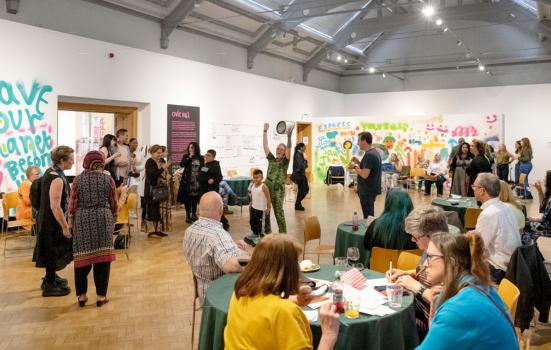After staging a takeover of a visual arts institution in Greater Manchester, Harry Meadley says cultural spaces should let the public represent themselves.

Harry Meadley
Many artists, galleries and museums have been doing excellent work delivering socially engaged, co-created, participatory - or one of those many phrases - projects in recent years. There has been an observable increase in this way of working, and as far as public institutions are concerned, it is arguably the dominant artistic form.
However, much of this work often sits outside of the main gallery spaces, is ancillary to a larger programme, or is still somewhat pre-determined by an artist or curator. When asked by Touchstones in Rochdale to consider an idea for a new exhibition which might re-imagine the role of the gallery in our still confusing post-Covid context, my starting point was to think about inverting this hierarchy.
What if the ‘community engagement’ was the central part? Or, one step further, what if the community determined their own programme? What if I as the artist, and the gallery team, was there to carry out the participants’ vision? What if the participants were any members of the public?
The outcome was Free-for-All, ‘a new type of exhibition where the gallery is yours’, an experiment in seeing what would happen. The short answer: a lot. It may be a too soon to properly reflect upon and share what we’ve learnt, but we can certainly express the thinking behind it, which might encourage others to consider doing similar.
Exhibitions for the public, by the public
I keep hearing that gallery and museum visitor figures have dropped since the pandemic. The reasons aren’t immediately clear but my (semi-serious) theory is that the people who got lockdown puppies (myself included) have found that having a dog and gallery-going isn’t particularly compatible due to limited accessibility. In fact, as part of Free-for-All, we introduced bi-weekly dog days that proved to be hugely popular.
Yet millions found themselves beginning or returning to all sorts of d creative practices throughout lockdown. As a result, we have more people wishing to exhibit or present their newly developed work than ever.
An example of this in Rochdale was the Public Health Annual Report 2020-2021, tellingly subtitled ‘or how creativity got us through lockdown’, which clearly demonstrated the need and desire for opportunities where people can present their work publicly.
One element of Free-for-All dubbed We Want Your Art became an open invitation to anyone living in the borough to add their own artworks to an ever-growing display - an open show with no selection process. Very soon we got to over a hundred works, many of which came with stories of it being their first ever painting, no one having ever seen their work before, or in one case, an elderly gentleman currently in a hospice who had dreamed his whole life of exhibiting his work in the gallery. These are no small things.
Preserving municipal museums and galleries
Access to space in which people can present, host, organise or gather is in increasingly limited supply, yet at the same time we have galleries and museums desperate to connect with their local communities. Nationally libraries and community, youth and leisure centres have been closing down. One of the main things protecting municipal art galleries and museums from potential closure is their role in presiding over publicly owned assets - something that became apparent to me during Touchstones’ 2019 project called But what if we tried? in which we display as much of a publicly owned collection as possible in a single exhibition.
Without these collections (despite issues around representation or restoration), we might not have as many municipal galleries or museums as we do. And personally, I doubt someone like me would have ever become an artist, were it not for the existence of Leeds Art Gallery. But unless municipal galleries and museums start winning the favour of the wider public, the higher the chance those assets will be sold off. There will be no galleries needed.
Despite being an artist for over fifteen years and having exhibited nearly a hundred times, I can still go into a gallery and feel on edge. When I say this to others who work in the arts, they often admit the same. We can’t ignore this, and certainly not when thinking about the wider public who may have never visited art spaces before. How daunting could it feel? How do we change that?
An opportunity for all
What changes my relationship with a gallery is the opportunity to exhibit there, especially when it is open ended. That feeling of wonder and excitement at imagining all the possibilities. The feeling of permission. The artwork in Free-for-All, as the artist behind it, is about trying to extend that feeling to anyone who comes through the doors. It’s is a space for people to do whatever they want.
From many of the conversations I’ve had with people wanting to do things at Touchstones, and from their positive reception to such an offer, there is cause for hope. We’ve put on an over-60s tea dance, CIC workshops, poetry readings, pop-up exhibitions, a bouncy castle, Asian LGBT Pride, DJ workshops, drumming circles, an art school reunion, a bubble show and many more. All were free to attend, all put on by local organisations, community groups, and individual members of public.
By opening up the use of the gallery spaces to the public, encouraging their involvement through dialogue, we have generated a jam-packed, diverse public programme that celebrates not just the community, but the importance and value of civic space itself.
Harry Meadley is an artist and lecturer in Fine Art at Leeds Beckett University.
![]() https://harrymeadley.studio/
https://harrymeadley.studio/
![]() @Touchstones
@Touchstones
Free-for-All was at Touchstones Rochdale with funding and support from Art Fund, Arcon Housing Association and Rochdale Borough Council.




